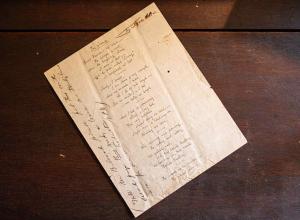Richard Minsky's Metaphoric Binding for "It Can't Happen Here"
Almost a year ago today, book artist Richard Minsky announced his purchase of a 1935 first edition It Can't Happen Here, a dystopian political novel by Sinclair Lewis that experienced a surge in popularity after the 2016 presidential election. At the time, Minsky wrote, "I'm thinking about materials to use for a book shrine, like Pop Delusions, or whether it should be a reading chair, like Freedom of Choice." The product of that creative spark is a stunning binding that combines leather, gold, paint -- and the artist's blood.  As a longtime contributor to FB&C, Minsky hardly needs an introduction here, but I would like to note that he recently received the 2017 Guild of Book Workers Lifetime Achievement Award for service to the profession of the book arts. Now that his latest "book shrine" has been completed, I wanted to hear more about this compelling project.
As a longtime contributor to FB&C, Minsky hardly needs an introduction here, but I would like to note that he recently received the 2017 Guild of Book Workers Lifetime Achievement Award for service to the profession of the book arts. Now that his latest "book shrine" has been completed, I wanted to hear more about this compelling project.
RRB: Tell me about the impetus for this undertaking. Had you read It Can't Happen Here before?
RM: I read it for the first time after the 2016 election, when it garnered a lot of attention and again became a bestseller. My original intention wasn't to do a binding. In the novel the protagonist is a newspaper editor in Vermont. A populist buffoon is elected president of the USA and becomes a demagogue. All laws were made to benefit corporations. The editor and other members of the New Underground Resistance steal "an old hand printing-press" from the basement of the newspaper office, and take 8-point type, a pocketful at a time. They publish a four-page pamphlet titled Vermont Vigilance. One way of distributing the pamphlets was to surreptitiously insert them into other publications.
Last April I was Artist-in-Residence at the Cary Graphic Arts Collection, Rochester Institute of Technology, where I reified the fictional pamphlet, printing Vermont Vigilance on the Kelmscott/Goudy Albion handpress that William Morris acquired to print The Works of Geoffrey Chaucer. Frederic Goudy brought the press to America in 1924. I designed the pamphlet using typefaces that existed at the time of the story, and planned to insert them into copies of the first edition of the book.  RRB: You made two bindings, right? One white goatskin, the other calf? Will there be more?
RRB: You made two bindings, right? One white goatskin, the other calf? Will there be more?
RM: The first binding was alum-tawed goatskin with an inlaid panel made to look like pied 8-point type in a pool of black ink, covered in blood. The type is Garamont, a face Goudy designed in 1921. The original drawings for Garamont are in the Cary Collection. Some of the red on the cover is my blood, but most of it is acrylic paint, which looks more like fresh blood than blood does after a short time. The front endpaper is the first leaf of Vermont Vigilance, and the back endpaper is the folded pamphlet.
I just finished a second copy, in black calf, with Vermont Vigilance as the basis of the panel. For this one I inserted the pamphlet rather than glued it in. Both versions use the same copper die for stamping the gold spine, and I've stamped three additional alum-tawed skins with the spine design, in case I locate additional copies of the first edition suitable for binding.
RRB: Why was it important to you to use blood? Have you ever done that before--or heard of another binder doing it?
RM: I used my blood because it evokes a metaphor of the book--that people are willing to give their blood to resist fascism. Many of the characters are bloodied. Some survive, some die. The images on the covers represent what happens when the Corpos discover where the resistance is printing the pamphlets. The headline in Vermont Vigilance is "How Many People Have the Corpos Murdered?"
I haven't used my blood before as a metaphoric material, though I occasionally have put a drop on a work to provide DNA authentication. I haven't seen any other bookbindings that use the binder's blood, but I'm certainly not the first artist to use their blood as a significant material in their work. Barton Lidicé Beneš immediately comes to mind. Lethal Weapons was a series of works created in the 1990s with his own HIV-infected blood.
Images courtesy of Richard Minsky















